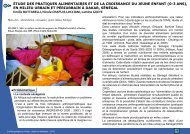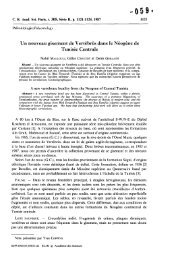L'anthropologie du vivant : objets et méthodes - CNRS - Dynamique ...
L'anthropologie du vivant : objets et méthodes - CNRS - Dynamique ...
L'anthropologie du vivant : objets et méthodes - CNRS - Dynamique ...
- No tags were found...
You also want an ePaper? Increase the reach of your titles
YUMPU automatically turns print PDFs into web optimized ePapers that Google loves.
Computed tomography (CT) and magn<strong>et</strong>ic resonance (MR) imaging to b<strong>et</strong>ter understandand characterize brain and cranium growth and development.Fernando VENTRICEThe human brain is a very complex organ that presents severalunsolved enigmas, its evolution being perhaps the most intriguingone. This topic is deeply related to the evolution of our own species,and that is the reason why several paleoanthropologists are trying atpresent to understand the process that gave origin to human brain.Unfortunately, this organ is formed by soft tissue which is not sensitiv<strong>et</strong>o the fossilization process. Therefore, we must deal with indirectevidences to infer brain evolution from the fossil record: (1) the wellknown cranial capacity; the impressiones gyrorum of the differentbrain gyri and sulci (i.e. lunate sulcus, perisylvian asymm<strong>et</strong>ries); thep<strong>et</strong>alia patterns; and the anatomical compared studies on brains ofextant primates (Holloway 1996; Semendeferi <strong>et</strong> al. 1997; Falk 2006;Schoenemann 2006). Consequently, the fossil record provides onlyendocranial information. To b<strong>et</strong>ter understand the clues provided bythis information on our brain evolution, it is essential to d<strong>et</strong>ermine theexisting relationship b<strong>et</strong>ween the brain and the endocranium, andhow this relationship develops throughout the maturation process inour species.Nowadays we have new m<strong>et</strong>hodologies to address this question.In this short manuscript two scanning techniques, which may helpto b<strong>et</strong>ter understand and characterize growth and development ofhuman brain and cranium, will be d<strong>et</strong>ailed. These two techniquesare computed tomography (CT) and magn<strong>et</strong>ic resonance (MR)imaging (Guy, Ffytche 2005). Their physics principles will beformulated, with special attention being paid on the advantagesand disadvantages of each technique and their correspondingdifferences. At the same time, a brief explanation on how theirresults can be quantified to answer research hypothesis will begiven.The basic physics principle of CT scanning is the reconstructionof an object internal structure from different projections, which arebased on X-rays emitted towards the object from different angles.The object presents a vari<strong>et</strong>y of absorption rates depending onits constituent tissues. For this reason, when all projections areintegrated, CT images are much sharper than X-rays, showing ahigher definition not only in bone structures but also in soft tissues(Hsieh 2009).The MR physics principles are based on the resonance capacity ofcertain atoms, particularly the protons. When an object is exposedto a strong magn<strong>et</strong>ic field, the small magn<strong>et</strong>ic fields pro<strong>du</strong>ced bythe protons g<strong>et</strong> positioned in a particular direction. After a radiofrequencypulse application, an exciting and relaxing response ofthe protons is obtained. This response is called resonance, and canbe measured and quantified to d<strong>et</strong>ermine the type of tissue thatis being analyzed (Brown, Semelka 2003). In the human body, themolecule responsible for most of this kind of resonance is water(H 2 O), since it contains two protons and is present in the tissues ina high percentage.To highlight the differences b<strong>et</strong>ween these two scanning techniquesis useful to compare the image stacks obtained through each of them.On the one hand, a typical axial head CT image s<strong>et</strong> contains 275axial images of 512 x 512 pixels, which are obtained in a scanningsession lasting 15 seconds and have a voxel resolution equal to 0.5x 0.5 x 0.5 mm. This volum<strong>et</strong>ric CT stack occupies 144 Megabytes.On the other hand, a sagittal head MR image s<strong>et</strong> would contain 120sagittal images of 256 x 256 pixels, with a voxel size equal to 1.5 x 1x 1 mm, in a scanning session that lasts 10 to 15 minutes. This kindof MR stack occupies 16 Megabytes. With this information in mindit is evident that CT images are scanned faster and have a muchhigher resolution than MR images. So, what is the advantage of MRover CT?Since these imaging techniques extract different information fromL’anthropologie <strong>du</strong> <strong>vivant</strong> : <strong>obj<strong>et</strong>s</strong> <strong>et</strong> méthodes - 2010 109











